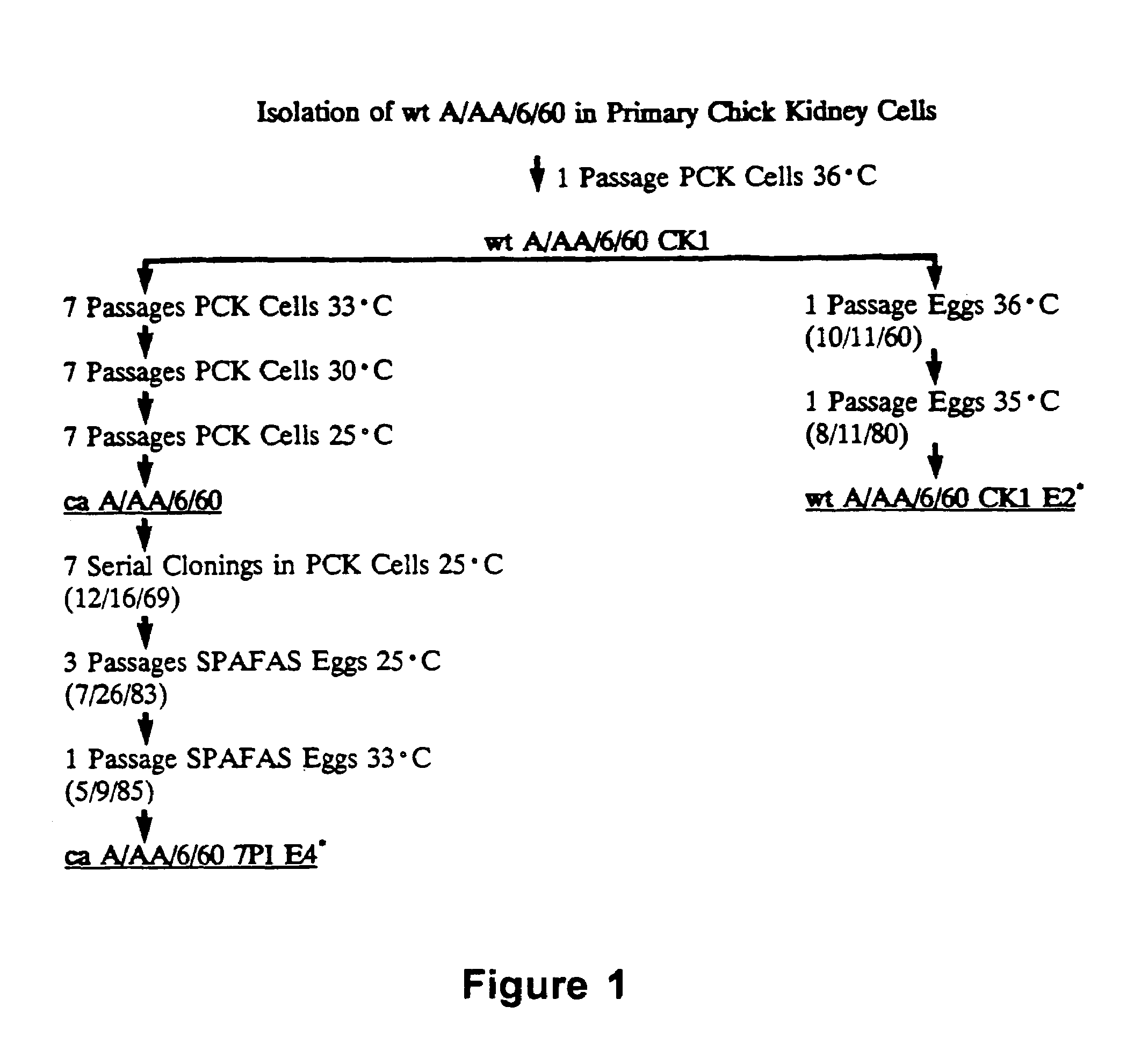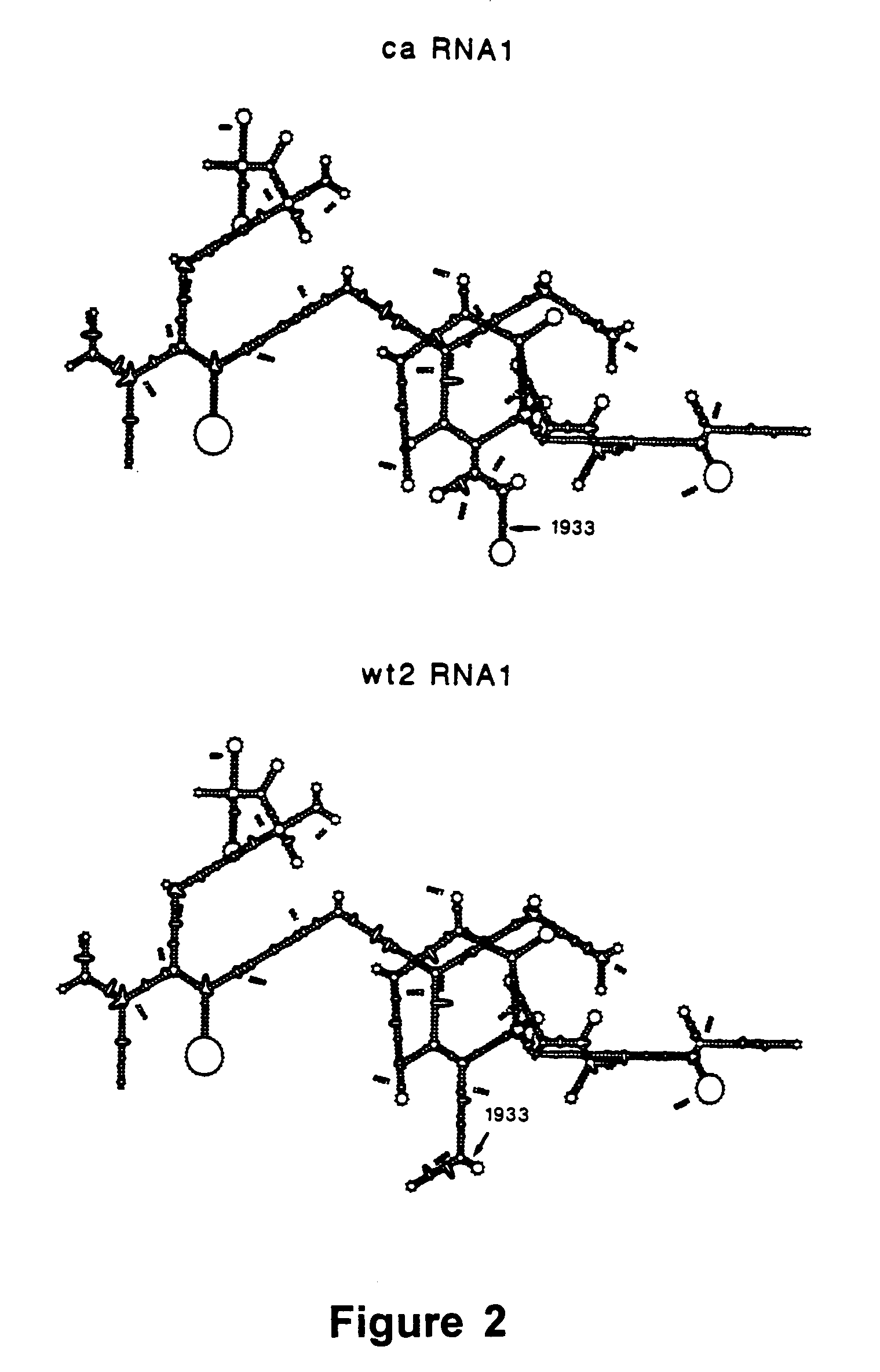Cold-adapted influenza virus
a technology of cold adaptation and influenza virus, which is applied in the field of cold adaptation of influenza virus vaccine, can solve the problems that virtually nothing has been known about the molecular basis of cold adaptation
- Summary
- Abstract
- Description
- Claims
- Application Information
AI Technical Summary
Benefits of technology
Problems solved by technology
Method used
Image
Examples
specific example 1
Sequencing
A. Materials and Methods
[0041]Viruses. All viruses were supplied by Professor H. F. Maassab at the University of Michigan and the ca master strain and wild type progenitor strain viruses have now been deposited with the ATCC as previously set forth. Steps in the preparation of the ca master strain A / AA / 6 / 60 7PI (H2N2) live influenza virus and the wt A / AA / 6 / 60 (H2N2) egg passage 2(3) virus are shown in FIG. 1. In FIG. 1, PCK cells refers to primary chick kidney cells, SPAFAS refers to specific pathogen-free eggs and PI refers to plaque-purified. To guard against any possibility of mix-up in the two viruses, the passage history of both viruses was carefully traced and their separate identities were verified. Moreover, the two viruses were grown in different institutions and sequenced separately. The authenticity of the wt A / AA / 6 / 60 E2(3) virus is supported by sequence differences between the HA's and NA's of the cold-adapted and wild type viruses. Viruses grown in 11-day old...
specific example 2
Sequence Comparisons
[0064]Sequence of Wild Type Progenitor. Table 4 presents positions for each gene where the ca and wt 2(3) viruses have unique amino acids, by comparison to previous GenBank sequences. Webster, R. G., et al., Microbiol. Rev. 56(1):152-179 (1992). In Table 5, a comparison to data previously published is shown and differences between the wt 2(3) and ca sequences as set forth herein, and the previously published sequences, are shown in bold type and bracketed. In positions with mixed bases, the capital letter represents the predominant base. Some of these amino acids found only in the two ts A / AA / 6 / 60 viruses may be attenuating. However, many of the viruses reported in GenBank have been extensively passaged in the laboratory and will have accumulated mutations related to high relative fitness and host adaptation. Comparison to the A / AA / 6 / 60 wt 28 virus previously sequenced provides further insight into attenuating lesions. Cox, N. J., et al., Virol. 167:554-567 (1988...
specific example 3
Reassortant Schemes
A. Type A Reassortants
[0067]The following is a procedure for developing Type A 6 / 2 cold-adapted influenza virus vaccine (CAIV) reassortants.
Materials
[0068]Media. The media used in this sample were prepared using the following components: a) HBSS—500 ml HBSS (BioWhitaker 10-508); 0.5 ml gentamicin sulfate 50 mg / ml (BioWhitaker 17-518); and adjust pH to 7.0 using 0.5N NaOH; b) 2×Eagle's−500 ml HBSS (BioWhitaker 10-508); 10 ml BME amino acids (GIBCO 320-1051); 10 ml BME vitamins (GIBCO 320-1040); 10 ml L-glutamine (GIBCO 320-5030); and 0.5 ml gentamicin sulfate 50 mg / ml (BioWhitaker 17-518); adjust pH to 7.0 using 0.5N NaOH; c) 0.5N NaOH−2 g NaOH; 100 ml Type I deionized water; sterilize by autoclaving 250° C. for 15 min, liquid cycle.
[0069]Inoculum. Inocula were prepared as follows: Cold-adapted Master Strain Parent (A / Ann Arbor / 6 / 60-7PI)— make a 10−2 dilution in 2×Eagle's. Wild Type Parent—make a 10−1 dilution in 2×Eagle's. Combine equal volumes of the two diluted:...
PUM
| Property | Measurement | Unit |
|---|---|---|
| temperature | aaaaa | aaaaa |
| temperature | aaaaa | aaaaa |
| temperatures | aaaaa | aaaaa |
Abstract
Description
Claims
Application Information
 Login to View More
Login to View More - R&D
- Intellectual Property
- Life Sciences
- Materials
- Tech Scout
- Unparalleled Data Quality
- Higher Quality Content
- 60% Fewer Hallucinations
Browse by: Latest US Patents, China's latest patents, Technical Efficacy Thesaurus, Application Domain, Technology Topic, Popular Technical Reports.
© 2025 PatSnap. All rights reserved.Legal|Privacy policy|Modern Slavery Act Transparency Statement|Sitemap|About US| Contact US: help@patsnap.com


